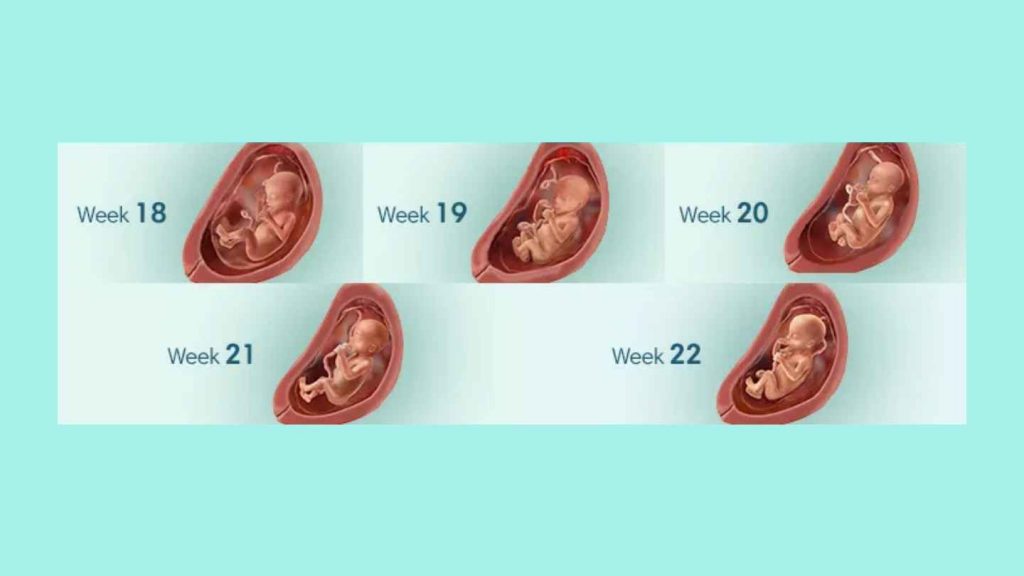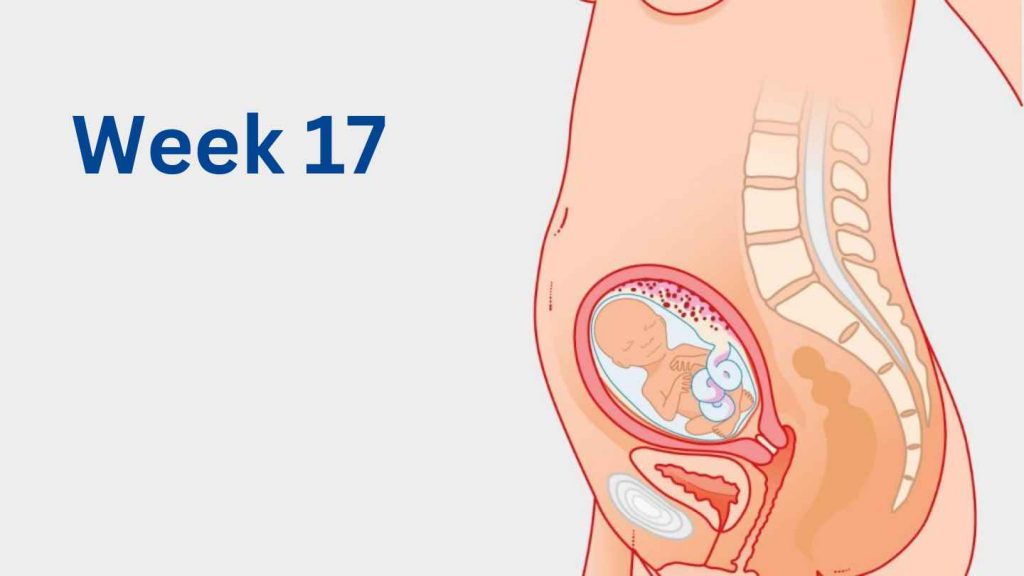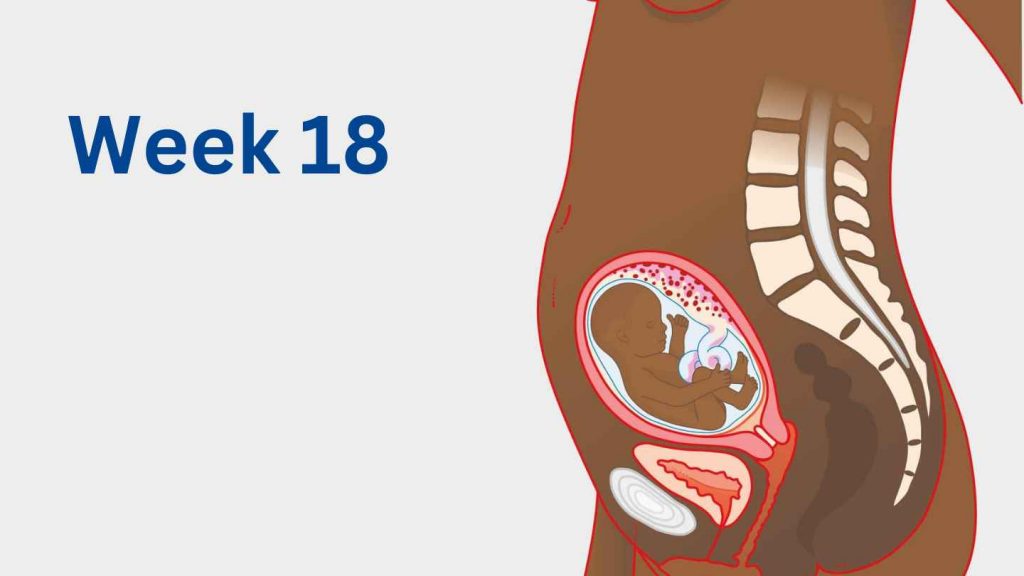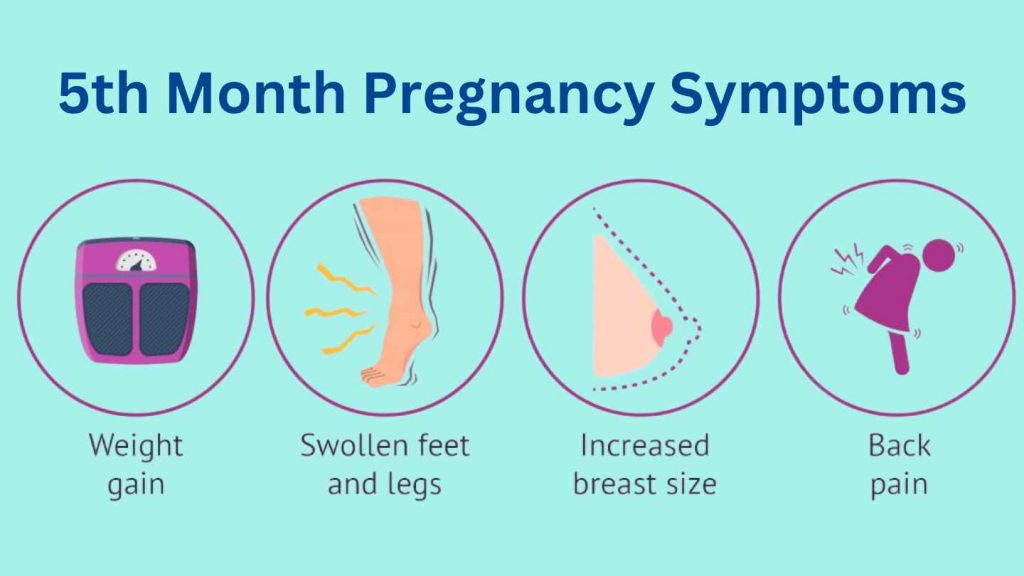Table of Contents
ToggleEven though every expectant mother’s body changes differently during pregnancy, your baby’s belly may be somewhat apparent when you’re five months along. You’ll probably spend this month getting used to the physical changes brought on by a growing bulge and your shifting centre of gravity. The fifth month is typically when people first experience foetal movements. Your stomach may feel like it’s fluttering or has butterflies in it. It is sometimes referred to as quickening.

Here you will learn more about what happens in the fifth month of your pregnancy, to help you with a stress-free period of the most exciting phase of your life.
Fetal Development Between 17-18 Weeks of Pregnancy
Week 17

At 17 weeks pregnant, you’re in your second trimester and 5th month of your pregnancy, which means a lot is changing now and over the next few weeks. Your little one weighs around 1-3 pounds and roughly 8-10 inches long. Most of the survival responses your unborn child will possess are still being refined during pregnancy.
At 17 weeks pregnant, your baby is developing and changing in the following ways, and you may feel:
- This week, little toenails are emerging.
- In addition to gaining weight, your child is also producing vernix, a protective layer on their skin.
- Over the upcoming weeks, you might begin to feel your baby move. Prepare yourself for some belly flutters!
- You might now notice a growth in the size of your breasts.
- The fragile cartilage in the baby’s skeleton is turning into bones.
- The umbilical cord, which connects the placenta and your unborn child, is becoming thicker and more vital.
- Sweat gland development of the baby has begun.
Week 18

You are in your fifth month of pregnancy at 18 weeks. Your third prenatal appointment will be scheduled between weeks 18 and 20 of pregnancy with the birth physician. As your baby develops and grows, you can notice changes in how you feel and appear.
During this week, the womb will shift further out of the pelvic region, and as the uterus grows into the abdomen, your waist will get smaller.
You now have a lot going on, so we’ve compiled a list of the highlights of being 18 weeks pregnant:
- The size of your baby is of a sweet potato at 18 weeks pregnant!
- Your child’s bones are beginning to become harder.
- As their ears start to grow from the side of their head, your baby may be beginning to recognise noises.
- You may feel your baby’s movements at 18 weeks pregnant or in the following weeks. Prepare yourself for those little belly flutters.
- You may experience backache and heartburn.
Symptoms During the Fifth Month of Pregnancy

At five months pregnant, you could start to feel some bothersome symptoms. They may consist of the following:
- Swollen feet: This symptom may be brought on by pregnant weight increase, fluid retention, and the pregnancy hormone relaxin. Relaxing relaxes the muscles throughout your body to prepare for childbirth. It also relaxes the joints, causing your feet to enlarge.
- Lower back pain: When you get used to your expanding belly around five months pregnant, your posture may begin shifting—your centre of gravity changes as your bump increases. As a result of your muscles having to work harder to maintain this additional weight and your altered body shape, your lower back may experience some pain.
- Dizziness: Your blood circulation may shift as your child grows, resulting in decreased blood circulation to your head. When you rapidly change positions or stand up, this may make you feel queasy.
- Nasal blockage: Clogged nose? Nosebleeds? or even a stuffy nose? These troubles can be caused by pregnancy hormones, which can dry out the mucous membranes of your nasal passages.
- Pregnant brain: If you frequently misplace your keys or have trouble remembering the password to your phone, don’t panic; forgetfulness is ordinary during pregnancy. Despite not being a recognised medical disease, it is pretty widespread. Numerous medical professionals link chronic forgetfulness to hormone fluctuations, stress, or lack of sleep.
- Inability to sleep: Finding a relaxing and comfortable position may be more difficult if the hump is larger. Try resting on your side with a pillow under your tummy and one between your knees to get more support.
- Braxton Hicks contractions: This month, it’s conceivable that you’ll start to feel these “practice” contractions. They can cause your stomach to tighten somewhat or to cramp more severely. After exercise or sex, or later in the day, you’re more prone to experience them. Sometimes it can be difficult to distinguish between Braxton Hicks and actual labour contractions.
Screenings and Tests in the Fifth Month of Pregnancy

Further tests may be recommended to you throughout the second trimester based on your age, family medical history, health, and other factors. They may consist of the following:
AFP4 screen/Multiple marker test/Quad screen: Between weeks 15 and 20, a blood test known as the multiple marker test, AFP4 screen, or quad screen is performed to check for chromosomal and neural tube abnormalities. Test results might be paired with first-trimester screening tests for more reliable findings.
Ultrasound: An ultrasound is a painless, safe test that creates images of the baby’s shape and location inside the uterus using sound waves. Most “level 2” or second-trimester ultrasounds are performed between 18 and 20 weeks to assess the baby’s anatomy and ensure they grow normally. In the second trimester, women with high-risk pregnancies could get a number of ultrasounds.
Glucose screening: This test looks for gestational diabetes, a temporary type of disease that can affect pregnant women and result in health issues for the unborn child, mainly if it goes undiagnosed or untreated. After consuming a sugary beverage, you’ll have a blood test an hour later to measure your glucose levels. It is typically performed between 24 and 28 weeks, but if a woman is more at risk for gestational diabetes, it may be done earlier.
Amniocentesis: This examination examines an amniotic fluid sample for indications of issues such as chromosomal diseases, genetic problems, and neural tube deformities. Women who are thought to be at a higher risk of having a baby with these diseases undergo it between 15 and 20 weeks.
Baby Bump at 5 Months Pregnant

Around five months, your belly should be apparent to others but not enormous enough to get in the way.
Don’t worry if people aren’t pointing out your pregnancy just yet. It’s acceptable if you’ve measured a little smaller or bigger, though.
Although it’s difficult to quantify how many pounds you should have acquired by month 5, you should anticipate putting on approximately a pound or two per week during the second trimester. A lot of people don’t put on much weight. While morning sickness prevents many people from gaining much weight in the first trimester, you might already be making up lost ground.
According to the Centers for Disease Control and Prevention, 25 to 35 pounds is the ideal weight gain for a person who was a normal weight before becoming pregnant.
Checklist for 5-Month Pregnancy
Do’s
- Your skin gets hypersensitive, and rashes seem to spread to other places of your body throughout the fifth month. Moreover, when your belly begins to expand, it is crucial to dress comfortably.
- Always strive to maintain a straight back. If your back needs it, take a break. Sleeping on the left side is always advised as it improves uterine blood supply.
- There are increased odds of constipation during the fifth month. Hence, it is crucial to maintain proper hydration. Consume water or fresh juices frequently.
- Even if it is not ideal for physically demanding activities now, it is crucial to continue moving.
Don’ts
- Don’t try to rise, sit down, or move quickly. Do everything gently. You don’t want to wake up your infant, who is fast asleep.
- Avoid alcohol and caffeine as they are bad for the baby’s growth. It is best to refrain from smoking altogether.
- Never consume carbonated beverages like cola. Eat less fat because it can give you heartburn.
- Papaya, pomegranate, and pineapple should not be consumed as they trigger uterine contraction.
- Avoid wearing tight clothing because it will limit your child’s mobility.
Sleeping Position
While lying on your back, breathing may be more difficult. Moreover, lying on your back might create stomach issues since your stomach presses down on your intestines. It’s not a good idea to sleep on your stomach, either. Your abdomen rubs against your growing uterus and enlarges your breasts when you are facing down. Your infant is currently safest lying on his or her side. Also, it makes you more comfortable as your abdomen expands. It is advised that experts lie on their left side as It improves circulation.
Sitting Position
- Straighten your back, raise your shoulders, and sit up straight. Your buttocks should rest against the chair’s back.
- Place a backrest at the curvature of your back and sit.
- Slouch down to the very end of your chair.
- Put equal amounts of your body weight on each hip.
- Avoid remaining seated for more than 30 minutes at a time.
- Adjust your workstation and chair height at your desk so you can sit close up to your desk. While keeping your shoulders relaxed, prop your elbows and arms on your desk or chair.
Healthy Eating Habits
Pregnant women must consume the proper nourishment during the fifth month of pregnancy. Protein is essential for developing the foetus’ muscles, skin, and organs, so it must be consumed in sufficient amounts for the child to grow strong and healthy.
To prevent or alleviate constipation during pregnancy, consume high-fibre meals like green leafy vegetables, carrots, cabbage, tomatoes, and beets. Include vitamin and mineral-rich meals as well because they benefit pregnant women by boosting their resistance. Such foods include green vegetables, fruits, pork liver, almonds, and fresh fruit. Pregnant women need roughly 1000 mg of calcium daily, which is essential for developing the baby’s skeletal structure.
Grains, including wheat, corn, rice, potatoes, and oats, are full of iron, vitamin E, and B vitamins, essential for the mother’s health and the growth of the foetus. Also, pregnant women must carefully drink plenty of water and milk. They should consume at least 2 litres of water daily and two glasses of milk to provide additional calcium for the developing foetus.
Conclusion
The fifth month of pregnancy changes your body and takes you closer to seeing your baby in your arms. The fifth month is typically when people first experience foetal movements. The fourth month’s pregnancy symptoms are still present this month. The most frequent side effects include nosebleeds, gum bleeding, constipation, breast changes, dizziness, and shortness of breath. By now, your breasts may have grown up to two cup sizes. Keep moving while you can, watch for the first movements, and say hello to your baby during the 20-week scan.
So to ensure a healthy delivery, schedule regular doctor’s appointments. Our Experts at Aastha Fertility are always ready to help you. Contact Us Now and Make your Pregnancy journey smooth and memorable with our expert guidance and support.
Frequently Asked Questions
1. What should a pregnant woman avoid during the fifth month?
Alcohol, caffeine, and raw meat and eggs should all be avoided during pregnancy, according to medical specialists.
2. How many weeks of pregnancy are five months?
You are halfway into your pregnancy and five months along at 20 weeks.
3. Can you still show at five months along?
Your body will begin displaying your baby’s growth between 16 and 20 weeks. Some women’s bumps might only be apparent in the third trimester or possibly the end of the second trimester.
4. How does the infant appear at five months?
Your baby’s fingers and toes are developed throughout the second trimester of pregnancy, which lasts for months 4, 5, and 6. Their teeth and bones grow denser, developing eyelids, eyelashes, eyebrows, nails, and hair. Your infant can even make faces, stretch, yawn, and suck their thumb.





Leave a comment